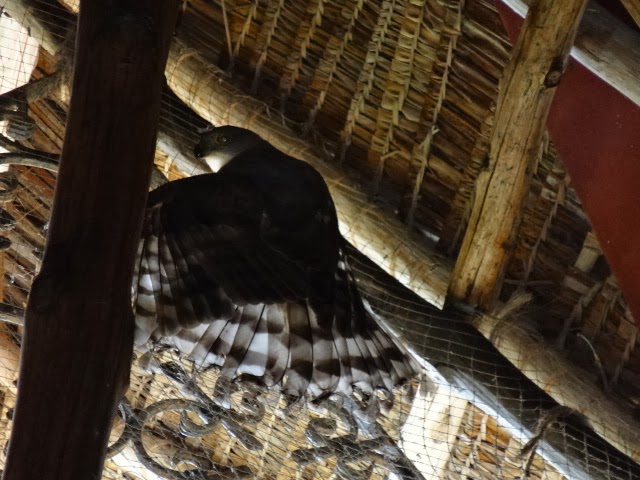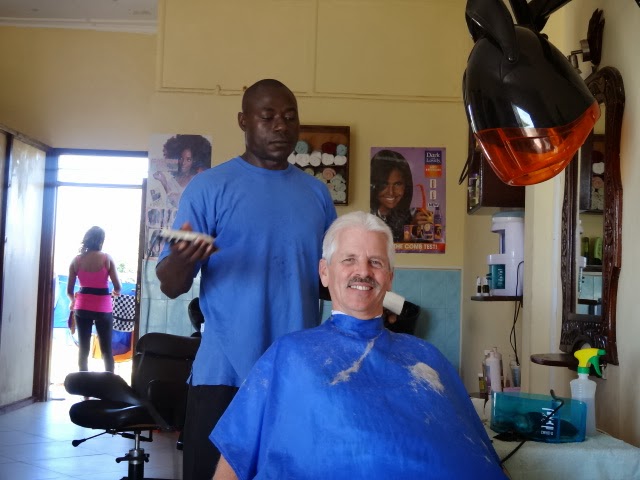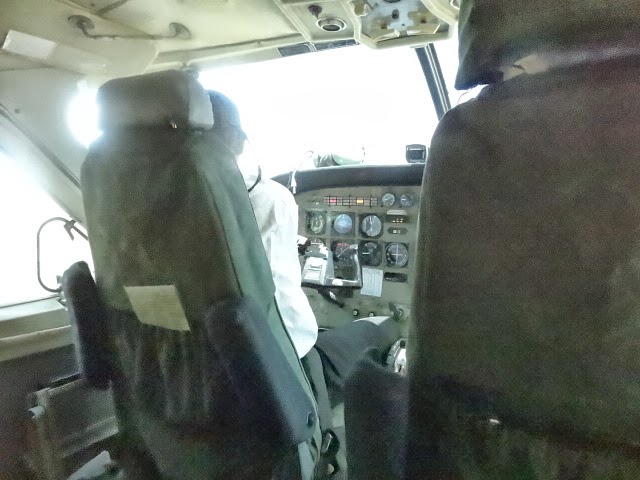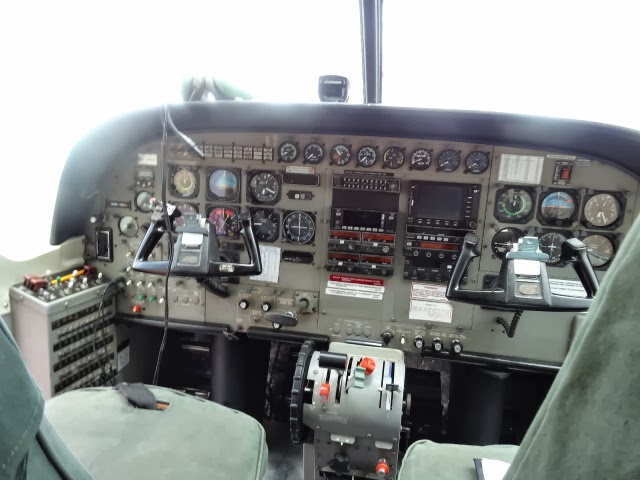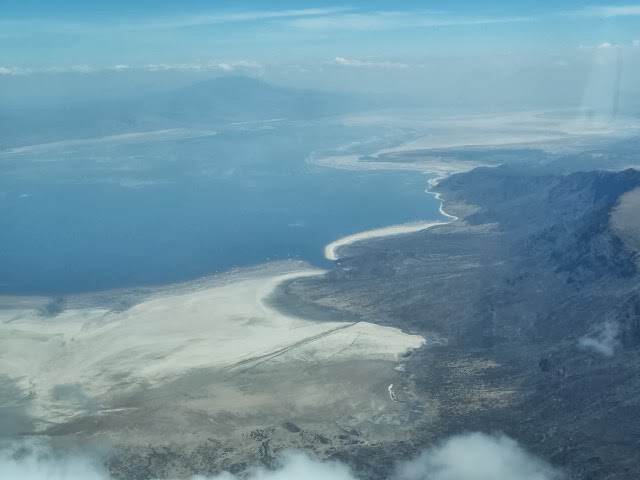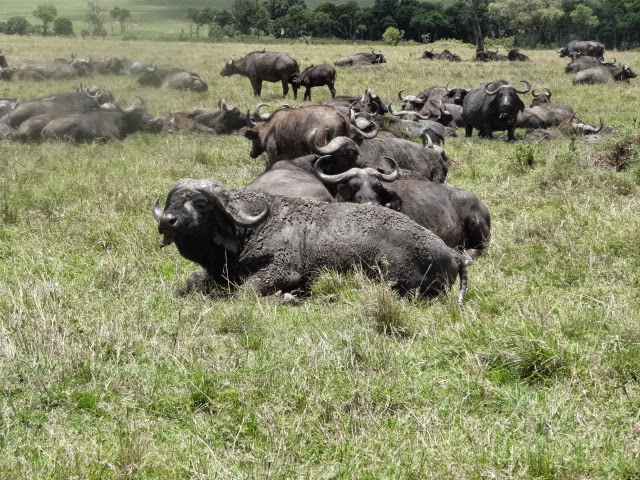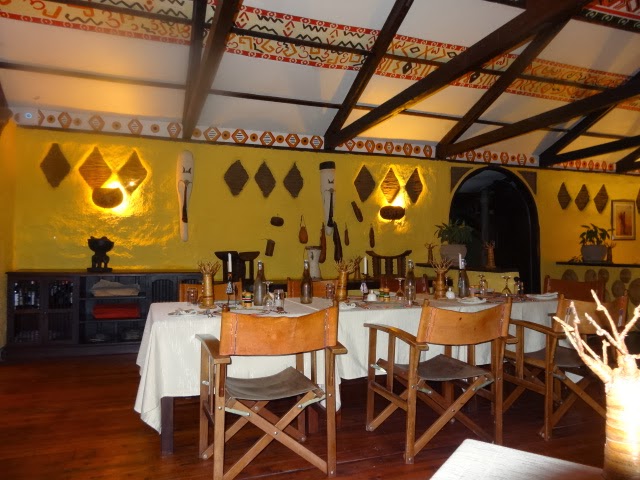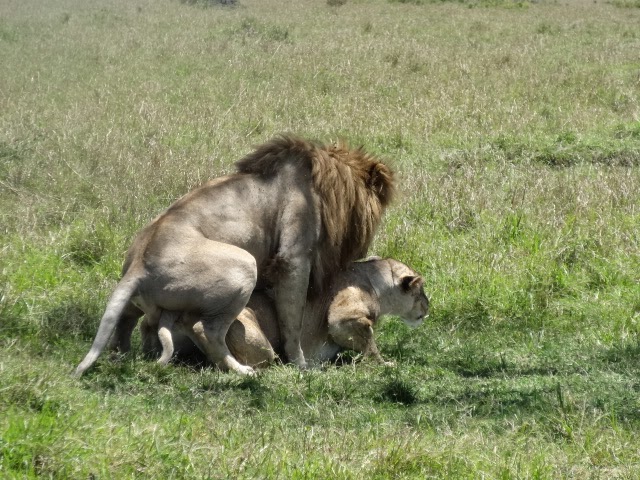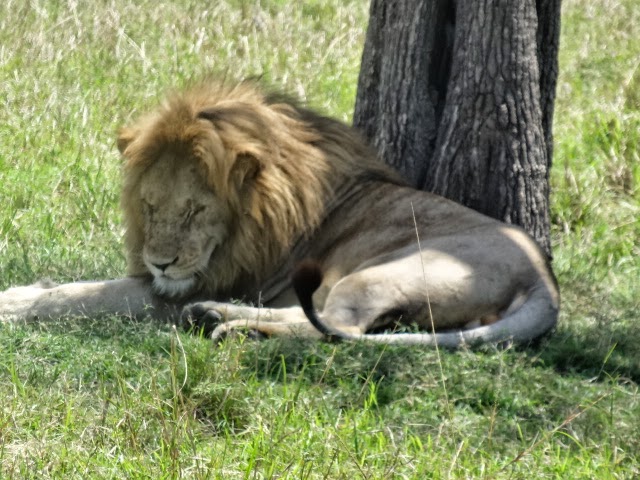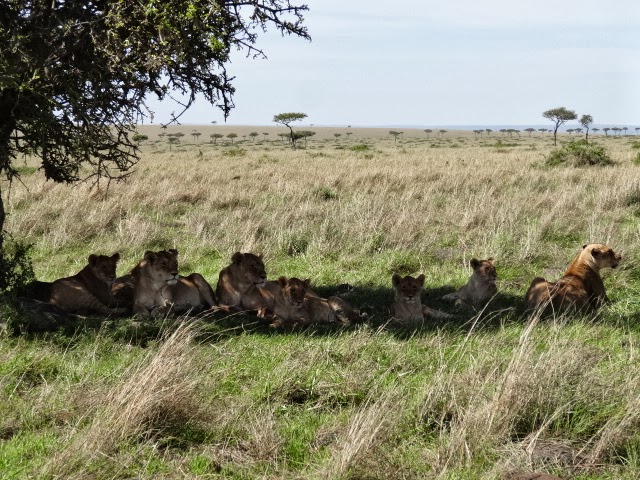 |
No, this was not a creature that we found in our bathroom during the night. It was my delectable entrée, delicate grill calamari with an octopus topper at dinner a week ago Saturday at the divine The Sands at Nomad.
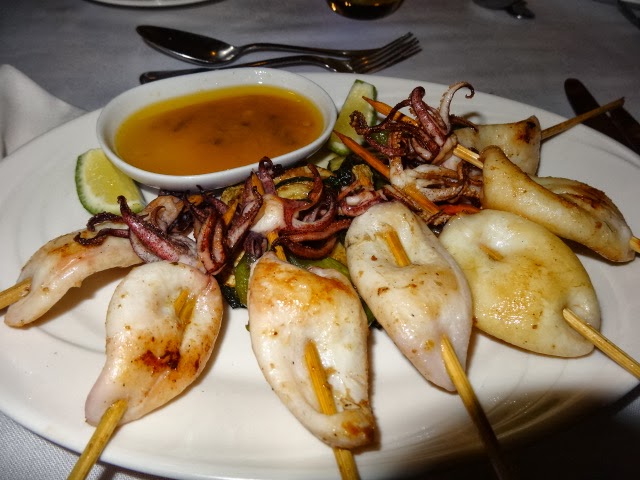 My dinner plate in its entirety, 7 skewered grilled garlic buttered calamari atop a plentiful portion of grilled non-starchy vegetables. I didn’t try the sauce fearing it may contain sugar.
|
 |
| Tom’s pork chop dinner that same evening with fried potato wedges and sautéed vegetables. |
 |
| Tom was looking forward to dining while the cool ocean breezes washed over us. |
I must admit, after that profound experience, everything we do in the future has the potential to be anti-climatic comparatively.
 |
| The menu offered many selections, all reasonably priced. For a frame of reference, KES $1000 equals US $11.76. |
We’ll have to shake loose that feeling. We will, especially when in less than six weeks we’ll have the opportunity to go on safari as often as we’d like living in Marloth Park, on the edge of Kruger Park, one of the largest game reserves in the world for a full three months. The company that owns several properties in the adjoining parks arrange game drives, day and night (and day walks) and we can participate at will.
 |
| With my shoulder painful after taking over 600 photos on safari, I fashioned this sling using a scarf. Keeping it immobile since we returned has been helpful. Luckily, it wasn’t painful until the day after our return. |
I can’t comprehend this option when at the end of our 4 days, 3 nights in the Masai Mara, all I could think of was, “I want more.” Living amid many of the animals in Marloth Park in itself will be greatly fulfilling and of course, fodder for endless photos to share here.
 |
| One of the many lounge areas in The Sands at Nomad, not only a resort and restaurant but a welcoming stopping point for thirsty visitors seeking a spot to relax and unwind either inside the bar or at the tables on the beach where food is also served.
|
It’s odd to admit that I’m dreaming of the next location while still in Kenya. We promised ourselves we’d live in the moment. The safari spoiled us. It’s not unusual to feel a sense of longing after such a life-changing experience. Wanting more. That’s us, humans. Always wanting more.
 |
| The lavish décor, embracing the genuine African theme, is pleasing to the senses throughout the property, including the guest suites as shown in the below photos. |
Realizing this dilemma, as we’d mentioned a few days ago, we’ve decided to start getting out more often, dining out three times a week, buying only enough groceries to last for four days, trying at least one new resort each week.
 |
| This past Saturday night, the 19th, after the complimentary taxi ride, we walked the short distance to the restaurant, we were enthused to see the property in daylight. Although shortly after 6:00 pm, we’d still have an opportunity to see a few of the suites and peruse the remainder of the property while still light.
|
These past two Saturday nights, we had the pleasure of dining at The Sands at Nomad, once after dark and the second time at 6:00 pm hoping to take photos while it was still light and of course, see the beach on the Indian Ocean.

 |
| Here’s the information about the unusual tree. |
 |
| Felix, the host for our tour of the suites, took us along a path parallel to the ocean to see the interesting and appealing grounds, a part of which included these private cottages.
|
With the help of Claudia, Assistant Manager via email, on both occasions were seated the same perfect ocean front table, now “our table.” Delightful Claudia came to greet us, chatting for a considerable time the first Saturday and this Saturday, her husband Richard, a charming gentleman, stopped for a chatty visit as well. We couldn’t have felt more welcome.
With our plan to arrive at 6:00 pm, Claudia had arranged for us to have a tour of the property with Felix showing us four suites from the more basic to the finest, photos of which are included here today.
 |
| The executive cottages were exquisite, pricey for most travelers but well worth the opportunity to see the interior. |
 |
| This stairway led to a loft area in one of the executive cottages. |
The ambiance of the resort is calming and welcoming, the service impeccable, and the food is fresh, seasoned to perfection with local spices, and presented with the utmost finesse and decoration, befitting the best-schooled chefs.
 |
| The appealing grounds inspired a lounge chair, a book and a cool beverage. |
A complimentary appetizer is served at each seating consisting of a plate of fried potato skins with a delectable sweet and spicy sauce on the side. With my restrictive diet, I don’t eat potatoes (or any starch) but enjoyed watching Tom eat them (I’ve learned to live vicariously through his eating foods that I cannot).
 |
| The suites were lavishly decorated with every possible amenity, including air conditioning, free Wifi and TV’s.
|
 |
| An outdoor shower in one of the cottage’s private yards.
|

 |
| Another cozy lounge area available to resort guests added to the ambiance of this exquisite property. |
The first Saturday night, we ordered off the menu. I ordered the most delicate and flavorful grilled calamari of my life, a favorite, as shown in the above photo. Tom ordered a piled high grouping of thin-sliced pork chops atop a bed of grilled vegetables with fried potato wedges on the side.
 |
| On Saturday night, our second visit to The Sands at Nomad, we both ordered the buffet as shown on this menu with no limitations on portions. I passed on the pasta, starches, and desserts, but was able to dine on their many other offerings, all delectable. The price of the buffet at KES $2000 is US $23.52 per person. In Belize, the buffet at Robert’s Grove, which we had most Saturday nights, although overall excellent, was US $35 per person. |
This recent Saturday night, the 19th, after our tour of the property, we had beverages at the bar. I had the best unsweetened ice tea ever; frothy, foamy, and refreshing, ordering a second glass once we were seated at our table. Of course, the first night of the waning full moon gave us a mesmerizing ringside seat.
 |
| The cooks at the grill were friendly and helpful in assisting us to make our decisions. |
This time, we both tried the nightly buffet, a changing cacophony of epicurean delights, predicated by the local catch of the day, seasonal vegetables, and an ever-changing menu.
 |
| Having selected literally every offered julienne vegetable, this was my stir fry with shrimp, calamari, and snapper, topped with a few dashes of soy sauce, the only sauce on the list of 10 that I surmised was truly sugar and grain-free. Regular soy sauce may contain a small amount of wheat that may trigger serious reactions in those with Celiac’s Disease. Since I consider gluten intolerant, the small amount didn’t seem to bother me. Overall, I’m opposed to consuming foods made with soy, based on its GMO status. But at times, one may choose to go with the flow when little else is available. |
The main meat station consisted of a choice of meats and seafood, as much as desired, stir-fried with the wide array of julienne vegetables lined up at the cooking station for our selection. In essence, it was a Chinese/Japanese type stir fry, cooked to order with a list of no less than 10 sauces from which to choose.
 |
| My stir fry with a side of snapper and buttered steamed vegetable. My mouth is watering as I write this. I can’t wait to go back for more of The Sands at Nomad’s fine food. |
 |
| My salad bar plate with more calamari and octopus, plus a cheese salad, inspiring me to make this for us, plus marinated eggplant, zucchini, and more. |
We didn’t partake of the offered beef kabobs, made fresh on the huge Teppanyaki grill, along with the stir fry. We simply had no room. The cooks were attentive and diligent in preparing our dishes exactly as preferred.
 |
| This is the two-sided salad bar with little doors, leaving food chilled and free from flies containing local dishes, none of which contained gluten, grains, starch, or sugar, I had a field day. To order the salad bar as a standalone was KES $700, US $8.23 but it wouldn’t work for me as it was lacking in protein, which I must include with each meal. |
In addition, there were two tables filled with more options, including soup, potatoes, rice, noodles, grilled vegetables, Kenyan barbecue pork, and chicken. I tried the chicken to announce to Tom, that if that alone had been my entire dinner along with the vegetables I would have been content. It was moist, flavorful, and fell off of the bone.
The most interesting salad bar closed behind individual, easily opening little doors at a glass-windowed cooling station, was irresistible, most of which fit in well with my dietary constraints. (Flour based sauces are seldom used in Kenya by fine chefs. They’ve learned the value of a good reduction sauce which in most cases, I am able to order as a side).
 |
| Tom’s plate, including his stir fry with no veggies other than onion and celery, barbecue pork, a side of roasted potatoes, and white rice. He didn’t try the included salad bar, but did go back for seconds and a small dessert consisting of custard with chocolate sauce along with a few mini cream puffs. |
Another feature offered by The Sands at Nomad is the complimentary taxi service, which, on both occasions, Gabriel showed up promptly at our guarded gates to pick us up. The return after dinner was equally seamless. Of course, we left a good tip.
As for the cost for both dinners, ordering off the menu on the first Saturday night, our total bill, including tax, tips, and service fees was KES $3932.70, US $46.24. This past Saturday, by ordering the buffet at KES $2000, US $23.52 per person, plus Tom ordered two cocktails as opposed to two beers the first time, our total including tax, tips, and service fees was KES $6650.10, US $78.18.

The buffet, in its uniqueness and varied options, maybe a choice we’d made on occasion, with a desire to try other items off of the menu. For me, on our next visit, I must repeat the grilled calamari and octopus as shown in the photo. It was divine.
Overall, The Sands at Nomad has proven to be much more than a restaurant and hotel, but a fine establishment for tourists and locals to visit for a relaxing and luxuriating respite from daily life.
We offer a special thank you to Claudia and Richard for making us feel welcomed, pampered, and at ease.
We’ll be back…



















